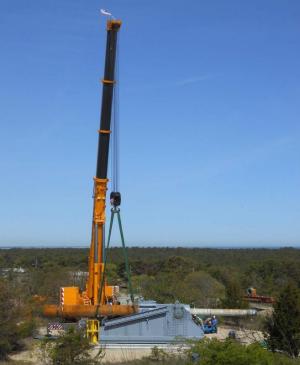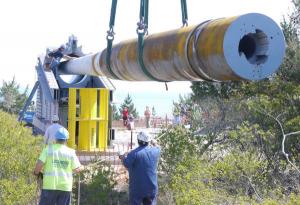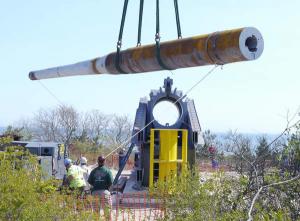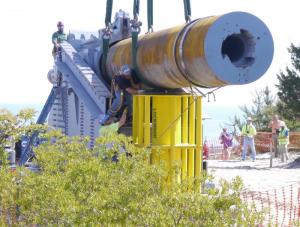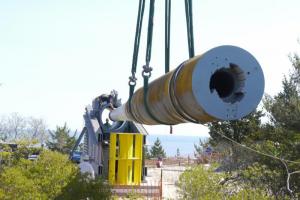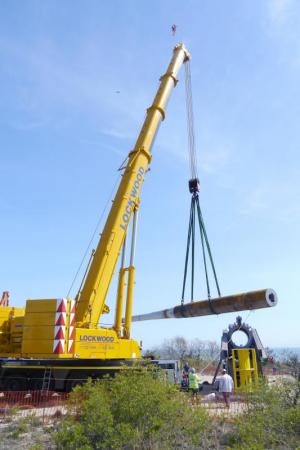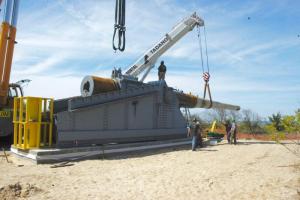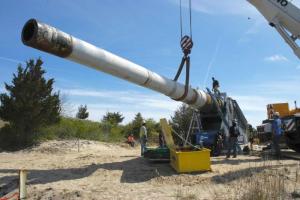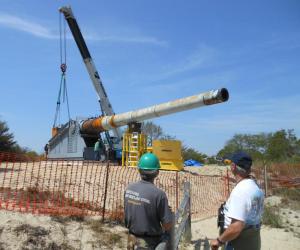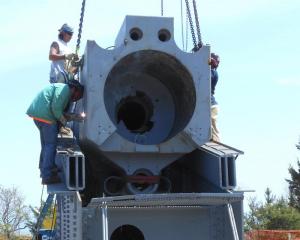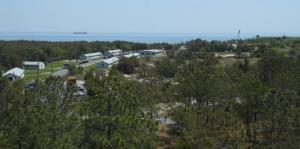Mighty Mo's gun finds permanent home at Fort Miles
From the deck of Mighty Mo during WWII, to later being within hours of being scrapped, to now living out life on the beach, the 16-inch gun installed May 20 at the Fort Miles Artillery Park has led quite a life.
“This is the very barrel the Japanese walked by when they surrendered to Gen. [Douglas] MacArthur,” said Gray Wray, Fort Miles Historical Association president, the morning the 66.6-foot-long, 120-ton barrel of the gun was slid into its slide.
The rusted parts of the gun were found in a Norfolk, Va., scrap yard, literally 36 hours away from being scrapped themselves, said Wray. Now, he said, it will be the centerpiece of the artillery park when it’s completed.
This gun is one of nine 16-inch guns on the deck of the USS Missouri that were used to destroy Japanese super ships during the war, said Wray. A round from this gun had the ability to pierce 18 inches of steel and travel 25.5 miles, he said.
“That's beyond the horizon,” he said.
The new gun is same type manufactured and installed at Fort Miles to safeguard Delaware River passage to industrial and fuel depots during World War II. Fort Miles' guns were sold for scrap following the war.
There was no special ceremony the morning of the barrel’s installation, but in a prepared statement, Gov. Jack Markell said the gun is an important piece of American history that will drive tourism and draw families and tourists to Fort Miles.
“Bringing new amenities and historical treasures to our parks not only provides an economic boost to the state, but is one of the reasons why Delaware State Parks was recognized nationally this year with the Gold Award as the best park system in the nation.”
The best view for the gun’s installation was from the hill on top of Battery 519, home to the association’s recently renovated museum, and there were about half a dozen people up there.
Cindy Todd, construction project administrator for the Division of Parks and Recreation, and Pierce Thompson, site manager for the division, weren’t going to miss the action.
Todd said this was the first time the state has been a part of a project like this.
“It’s a great project. It’s nice to see it all coming together,” she said.
James Rex is the northeast regional sales manager for Liebherr Cranes Inc., the German-based company who sold the 500-ton crane to Lockwood Brothers, the Virginia-based heavy-lifting experts, who were hired to do the installation. He said he was on top of the hill to take pictures for the calendar the company will produce for next year.
For individuals not in the heavy-lifting industry, the 500-ton crane looked enormous – but it didn’t look stressed when moving the barrel. Rex said it was the largest crane when he first got in the industry, but now he sells 1,000-ton and 3,000-ton cranes.
That said, using the crane to move the gun’s barrel into its final resting place is pretty cool, he said.
The gun’s assembly was not completed May 20, and it will require constant maintenance so it doesn’t return to its previously rusty and deteriorating state.
Dan Brown, association volunteer and retired military helicopter mechanic, is one of a handful of people helping Lockwood with the gun’s installation.
The morning of May 25, with his hard hat and camouflage pants on, Brown was watching carefully as the gun’s 38,500-pound yoke was being installed to the butt of the gun. He said the crew was trying to find the exact center of the yoke because the clearances are miniscule – somewhere in the 100 thousandths of an inch.
“But, it should slide ride on when they find that center,” he said, with a shrug of the shoulders.
Brown said after the yoke is complete, the installation of the recoil cylinders, also known as yoke rods, will be installed. Then the gun will be tilted at a 10-degree angle, just like it would have been when part of the original Fort Miles artillery, he said.
Wray said a promise to maintain the gun was a key part of the association’s proposal to the Navy, which donated the gun. He said the group has spoken with representatives from Dover Air Force Base’s Air Mobility Command Museum on best maintenance practices.
The airplane hulls are aluminum, and this gun is steel, but the concepts are the same, said Wray.
“Our bunker busters are going to be constantly maintaining the gun,” he said, referring to the more than three dozen association volunteers.











